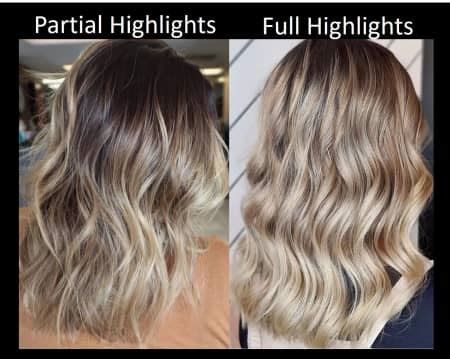In the realm of hair coloring, partial and full highlights offer distinct aesthetics and benefits. Understanding their differences empowers you to make an informed choice that aligns with your hair goals and preferences.

Partial Highlights: Subtlety and Gradual Enhancement
Partial highlights, also known as babylights or micro highlights, introduce subtle streaks of color to select sections of hair. They create a natural, sun-kissed effect while adding depth and dimension.
Pros:
- Blends seamlessly with natural hair color
- Low-maintenance touch-ups
- Minimal damage to hair
Cons:
- Less dramatic color change
- Can be time-consuming to apply
Full Highlights: Bold Transformation and Statement Style
Full highlights cover a larger portion of hair, resulting in a more noticeable color change. They brighten the overall appearance, add vibrancy, and create a striking contrast.
Pros:
- Dramatic color transformation
- Instant brightening effect
- Versatile for various hair textures
Cons:
- Requires frequent touch-ups (every 6-8 weeks)
- More potential for hair damage
- Can be expensive
Pain Points and Motivations
Partial Highlights:
- Pain points: Gradual color change, potential for blending too subtly
- Motivations: Natural enhancement, low-maintenance hair care
Full Highlights:
- Pain points: High maintenance, potential for damage, expense
- Motivations: Bold color transformation, statement look, brightening dull hair
Step-by-Step Application
Partial Highlights:
- Divide hair into small sections.
- Weave out strands of hair using a foiling or balayage technique.
- Apply bleach or color to the selected strands.
- Wrap in foil or leave open to create a softer effect.
Full Highlights:
- Divide hair into four equal quadrants.
- Create fine slices of hair throughout each quadrant.
- Apply bleach or color to the slices.
- Wrap in foil to lift color evenly.
Comparison of Pros and Cons
| Feature | Partial Highlights | Full Highlights |
|---|---|---|
| Color Change | Subtle, gradual | Dramatic, noticeable |
| Maintenance | Low-maintenance touch-ups | Frequent touch-ups |
| Hair Damage | Minimal damage | Potential for damage |
| Cost | Less expensive | More expensive |
| Naturalness | Blends seamlessly | Can create a more artificial look |
| Versatility | Suitable for all hair types | Versatile for various textures |
Additional Considerations
- Hair Thickness: Partial highlights are ideal for fine or thin hair, while full highlights work well on thicker hair.
- Budget: Partial highlights are more budget-friendly due to fewer touch-ups and reduced color used.
- Styling Time: Partial highlights require minimal styling, while full highlights may require additional blow-drying and flat-ironing to maintain vibrancy.
- Consultation: Consulting a professional stylist is recommended to determine the best highlight technique based on your unique needs.
Innova-Highlighting: A New Application
Combining the precision of partial highlights with the boldness of full highlights, “Innova-highlighting” emerges as an innovative approach. It involves creating strategic highlights of varying depths and sizes to achieve a customized, multi-dimensional effect.
Tables
Table 1: Partial Highlights vs Full Highlights Comparison
| Partial Highlights | Full Highlights | |
|---|---|---|
| Color Change | Gradual | Dramatic |
| Maintenance | Low | High |
| Hair Damage | Minimal | Potential |
| Cost | Less expensive | More expensive |
| Naturalness | Blends seamlessly | Can create a more artificial look |
Table 2: Partial Highlight Techniques
| Technique | Description |
|---|---|
| Foiling | Hair strands are wrapped in foil to lift color more quickly |
| Balayage | Coloring is painted onto strands of hair using a sweeping motion |
| Ombré | Gradual blending of two or more shades from root to tip |
Table 3: Full Highlight Techniques
| Technique | Description |
|---|---|
| Global | Full head of highlights |
| Half | Highlights on the top or bottom half of the hair |
| Front | Highlights on the front sections of the hair |
Table 4: Hair Damage Mitigation Tips
| Tip | Description |
|---|---|
| Use a deep conditioner | Replenishes moisture and prevents dryness |
| Avoid heat styling | Excessive heat damages hair |
| Get regular trims | Removes split ends and prevents breakage |
